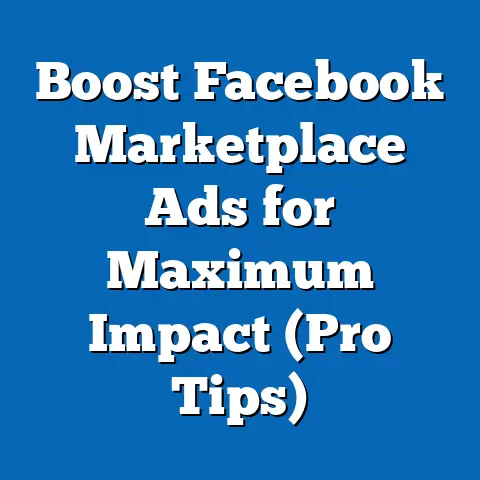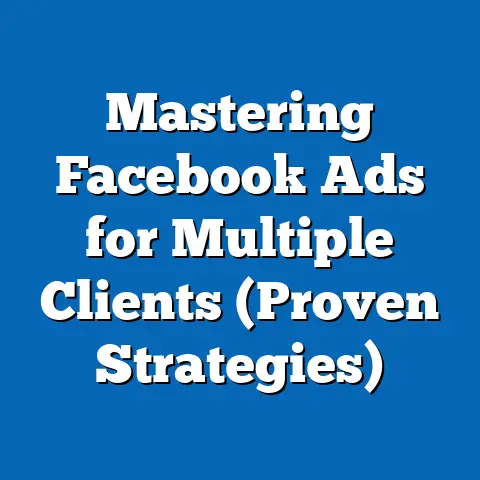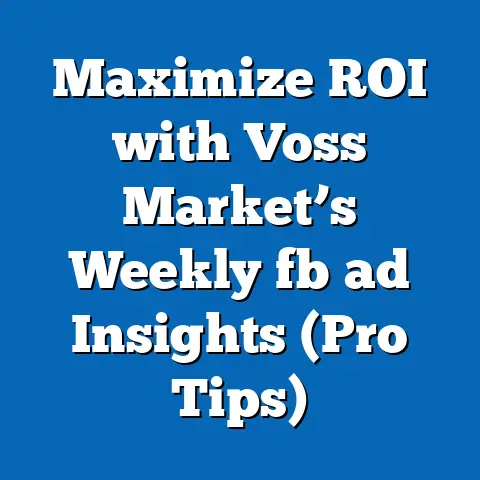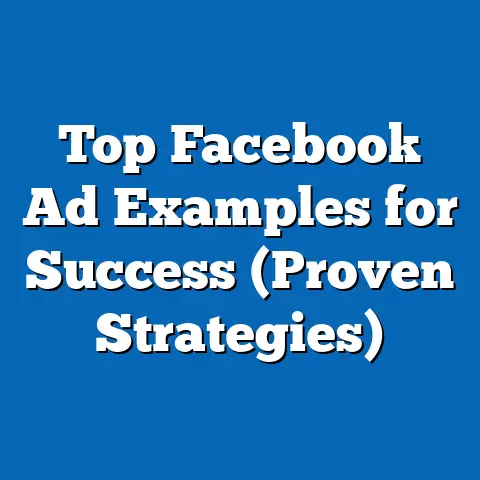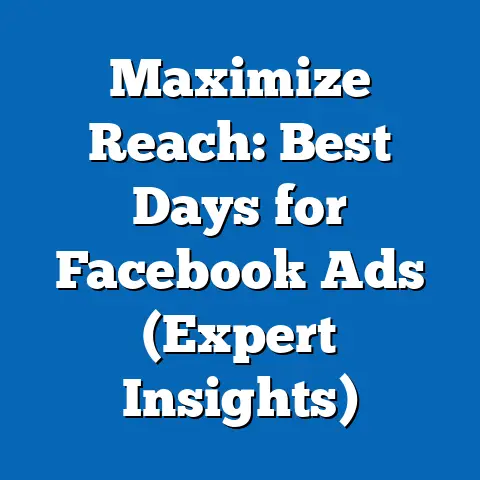Do Facebook Ads Drive Results? (Unlock Proven Strategies)
In an era where digital connectivity shapes nearly every aspect of daily life, the promise of a lifestyle upgrade—whether through financial success, personal branding, or entrepreneurial growth—has become a universal aspiration. For many, achieving this upgrade hinges on leveraging powerful tools like social media advertising to reach wider audiences, build businesses, or promote personal projects. Among these platforms, Facebook stands as a titan, with its advertising system offering unparalleled reach and precision to individuals and businesses alike.
Defining Characteristics of Facebook Ads: A Tool for Modern Ambition
Facebook Ads, launched in 2007 as a rudimentary advertising platform, have grown into a sophisticated system that allows users to target highly specific demographics with tailored content. With over 2.9 billion monthly active users as of 2023 (Statista, 2023), Facebook offers advertisers access to a vast, diverse audience, making it a cornerstone of digital marketing. Its defining features include advanced targeting options based on user behavior, interests, and demographics, as well as a variety of ad formats such as carousel ads, video ads, and lead generation forms.
Another key characteristic is the platform’s integration with Instagram, acquired by Facebook (now Meta) in 2012, which amplifies reach across visual and text-based content. Additionally, the use of machine learning algorithms in ad delivery ensures that campaigns are optimized for engagement, clicks, or conversions, often outperforming traditional advertising methods in cost-efficiency. These features make Facebook Ads not just a marketing tool but a potential engine for lifestyle upgrades, enabling entrepreneurs, small business owners, and even individuals to scale their influence or income.
However, the platform is not without challenges. Issues like ad fatigue, privacy concerns, and algorithm changes can impact effectiveness, underscoring the need for strategic planning and adaptability. Understanding these characteristics is crucial for assessing whether Facebook Ads can deliver the promised results.
Historical Context: The Evolution of Facebook Ads and Digital Ambition
To fully grasp the role of Facebook Ads in modern lifestyle aspirations, we must consider their historical evolution alongside broader societal shifts. When Facebook introduced its advertising platform in 2007, it was a novel concept—allowing businesses to place ads directly on users’ newsfeeds. This came at a time when the internet was becoming a central hub for commerce and communication, particularly for Millennials (born 1981–1996), who were early adopters of social media and digital entrepreneurship.
The late 2000s and early 2010s marked a cultural shift toward the “gig economy” and personal branding, fueled by economic uncertainty following the 2008 financial crisis. Many individuals turned to online platforms to create side hustles or full-time businesses, with Facebook Ads offering an affordable way to reach customers. By 2016, the platform had evolved with features like retargeting and lookalike audiences, coinciding with the rise of Generation Z (born 1997–2012) as digital natives who viewed social media as a primary tool for self-expression and income generation.
Significant events, such as the 2018 Cambridge Analytica scandal, brought scrutiny to Facebook’s data practices, impacting user trust and ad effectiveness. Yet, the platform adapted by introducing stricter privacy policies and tools like the Ads Library for transparency. This historical trajectory shows how Facebook Ads have mirrored societal trends—shifting from a novelty to a necessity for those seeking financial independence or a reimagined lifestyle in a hyper-connected world.
Societal Implications: Redefining Success Through Digital Reach
The societal impact of Facebook Ads extends beyond individual success stories; it reflects a broader redefinition of ambition and achievement in the digital age. For many, particularly younger generations like Millennials and Gen Z, the platform represents an opportunity to bypass traditional gatekeepers in business and media. A 2021 survey by Hootsuite found that 54% of small business owners credit social media advertising, including Facebook Ads, for their growth, highlighting its role in democratizing entrepreneurship.
However, this democratization comes with disparities. Access to effective ad strategies often requires financial investment, technical know-how, and time—resources not equally available to all. This creates a digital divide where affluent users or established businesses may see greater returns, while others struggle to compete, reinforcing existing inequalities.
Moreover, the cultural emphasis on “hustle” and online success, amplified by visible ad-driven success stories, can contribute to unrealistic expectations and mental health pressures. The societal implication here is twofold: while Facebook Ads can empower individuals to upgrade their lifestyles, they also reflect and sometimes exacerbate systemic challenges in the digital economy. A balanced perspective must acknowledge both the opportunities and the pitfalls of this powerful tool.
Do Facebook Ads Drive Results? A Data-Driven Analysis
Effectiveness Metrics: Quantifying Success
To determine whether Facebook Ads deliver results, we must first examine key performance indicators (KPIs) such as return on ad spend (ROAS), click-through rates (CTR), and conversion rates. According to a 2022 report by WordStream, the average ROAS for Facebook Ads across industries is approximately 6:1, meaning for every dollar spent, advertisers earn six dollars in revenue. This figure varies widely by sector—e-commerce businesses often see higher returns (up to 10:1), while service-based industries may hover closer to 3:1.
CTR, another critical metric, averages around 0.9% on Facebook, though well-optimized campaigns can achieve rates as high as 2–3% (WordStream, 2022). Conversion rates, which measure actions like purchases or sign-ups, average 9.21% across industries, significantly higher than Google Display Ads at 0.57%. These statistics suggest that, when executed effectively, Facebook Ads can drive substantial results, often outperforming other digital advertising channels.
Yet, raw numbers only tell part of the story. Success depends on factors like audience targeting, creative quality, and campaign objectives. A poorly designed ad or misaligned audience can yield negligible results, underscoring the importance of strategy over mere expenditure.
Case Studies: Real-World Outcomes
Examining real-world applications provides deeper insight into the platform’s efficacy. Take the case of a small e-commerce brand, “EcoWear,” which launched in 2020 with a modest budget of $500 for Facebook Ads. By targeting eco-conscious Millennials with video ads showcasing sustainable products, EcoWear achieved a ROAS of 8:1 within three months, scaling monthly revenue from $2,000 to $16,000 (Shopify Case Study, 2021). This success highlights the potential for lifestyle upgrades—transforming a side project into a viable business.
Conversely, not all stories are triumphant. A freelance graphic designer reported spending $300 on Facebook Ads to promote services but saw only a 1:1 ROAS due to vague targeting and uninspired ad copy (Freelancer Forum, 2022). These contrasting outcomes illustrate that while Facebook Ads have the potential to drive results, they are not a guaranteed solution without careful planning and execution.
Influencing Factors: What Drives or Hinders Success?
Several factors influence the effectiveness of Facebook Ads, spanning technological, economic, and social dimensions. Technologically, the platform’s algorithm prioritizes ads with high engagement, meaning creative content—compelling visuals, clear calls-to-action, and emotional resonance—is critical. Economic factors, such as ad costs, also play a role; the average cost-per-click (CPC) on Facebook is $1.72, though it can spike in competitive industries like finance or during peak seasons like the holidays (WordStream, 2022).
Socially, user behavior and trust impact ad performance. With growing privacy concerns—exacerbated by events like the iOS 14 update in 2021, which limited tracking—advertisers must adapt to less precise data while maintaining transparency. These dynamics suggest that while Facebook Ads can be a powerful tool for lifestyle enhancement, their success is contingent on navigating a complex interplay of external and internal variables.
Proven Strategies for Maximizing Results with Facebook Ads
1. Precision Targeting: Know Your Audience
One of the most effective strategies for driving results with Facebook Ads is leveraging its granular targeting capabilities. Define your audience based on demographics (age, location), interests (hobbies, liked pages), and behaviors (purchase history, device usage). For instance, a fitness coach aiming for a lifestyle upgrade through client acquisition might target users aged 25–40 who follow fitness influencers and have engaged with health-related content.
Lookalike audiences—groups similar to your existing customers—are another powerful tool. Studies show that campaigns using lookalike audiences can increase conversion rates by up to 30% (Facebook Business, 2021). Precision targeting ensures your ad budget is spent on those most likely to engage, maximizing returns.
2. Compelling Creatives: Stand Out in the Feed
With users scrolling through hundreds of posts daily, your ad must capture attention within seconds. Invest in high-quality visuals—bright images or short, engaging videos perform best, with video ads seeing 48% more engagement than static ones (Social Media Examiner, 2022). Craft concise, benefit-driven copy that addresses pain points; for example, “Struggling to grow your business? Reach 1,000+ customers with one click!” resonates more than generic messaging.
A/B testing different creatives is also crucial. Run multiple versions of an ad with varying headlines or images to identify what resonates most, refining your approach over time. This iterative process can transform a mediocre campaign into a high-performing one, directly impacting your lifestyle goals.
3. Optimize for Conversions: Focus on the End Goal
Rather than aiming for likes or clicks, design campaigns with specific conversions in mind—whether it’s sales, sign-ups, or app downloads. Use Facebook’s Pixel, a tracking tool, to monitor user actions on your website and optimize ads for those who are most likely to convert. A 2020 study by HubSpot found that campaigns optimized for conversions saw a 25% higher ROAS compared to those focused on traffic alone.
Additionally, retargeting—showing ads to users who previously interacted with your brand—can boost conversion rates by 70% (Invesp, 2021). For someone seeking a lifestyle upgrade through e-commerce, this strategy can turn casual browsers into loyal customers, building sustainable income streams.
4. Budget Management: Start Small, Scale Smart
One common pitfall is overspending without testing. Begin with a small daily budget—$5 to $10 per day—and monitor performance over a week. Once you identify winning ads, gradually increase spending while maintaining a close eye on ROAS. This approach minimizes risk while allowing for scalable growth.
Seasonal trends also matter. Allocate higher budgets during peak times like Black Friday, when user intent to purchase is higher, potentially doubling conversion rates (Facebook Business Insights, 2022). Smart budgeting ensures that your investment in Facebook Ads aligns with long-term lifestyle aspirations without financial strain.
5. Stay Agile: Adapt to Platform Changes
Facebook’s algorithm and policies evolve frequently, impacting ad performance. Stay informed about updates—such as changes to tracking post-iOS 14—and adjust strategies accordingly. Joining online communities or following industry blogs can provide real-time insights into emerging best practices.
Agility also means responding to data. If an ad underperforms after 48 hours, pause it and analyze why—whether it’s targeting, creative, or messaging. This adaptability is key to sustaining results, especially for those relying on ads for consistent income or personal growth.
Generational Perspectives: Who Benefits Most from Facebook Ads?
Millennials: Digital Pioneers Seeking Stability
Millennials, often burdened by student debt and economic instability post-2008, have turned to digital platforms like Facebook Ads to build side hustles or full-time careers. Their tech-savviness and early adoption of social media give them an edge in navigating ad tools, with many using them to market freelance services or e-commerce ventures. A 2022 Pew Research study found that 62% of Millennial entrepreneurs use social media ads as their primary marketing channel.
However, their results vary based on disposable income for ad spend and competition in saturated markets. For Millennials, Facebook Ads often represent a path to financial stability—a critical component of a lifestyle upgrade—but require persistence to stand out.
Generation Z: Digital Natives with Creative Flair
Gen Z, raised on social media, views platforms like Facebook and Instagram as extensions of their identity and income potential. They are more likely to use ads for personal branding—promoting content creation or niche products—with a knack for viral, visually driven campaigns. Data from Sprout Social (2023) indicates that 70% of Gen Z users trust influencer-style ads, making peer-driven campaigns particularly effective for this group.
Yet, their limited financial resources and shorter attention spans can hinder sustained ad investment or strategy. For Gen Z, Facebook Ads are less about traditional business growth and more about creative expression and quick wins in the creator economy.
Baby Boomers and Gen X: Late Adopters with Purchasing Power
Older generations like Baby Boomers (born 1946–1964) and Gen X (born 1965–1980) are less likely to use Facebook Ads for personal ventures but often engage as consumers or small business owners. Boomers, with higher disposable income, are a prime target for advertisers, while Gen X may use ads to sustain established businesses rather than launch new ones. A 2021 AARP report noted that 45% of Boomers respond to targeted ads for products like health services or travel.
Their challenge lies in tech adoption—many rely on younger staff or agencies to manage campaigns. For these generations, Facebook Ads are less about lifestyle reinvention and more about maintaining relevance or profitability in a digital world.
Workplace and Economic Implications: Transforming Careers and Commerce
The effectiveness of Facebook Ads has far-reaching implications for the workplace and economy. For individuals, mastering ad strategies can lead to remote, flexible careers in digital marketing or entrepreneurship, aligning with the growing demand for work-life balance. Companies like Upwork report a 30% increase in freelance digital marketing roles since 2019, many tied to social media ad expertise (Upwork Annual Report, 2022).
Economically, the success of Facebook Ads fuels the growth of small and medium enterprises (SMEs), which account for 90% of global businesses (World Bank, 2021). When SMEs thrive through affordable advertising, local economies benefit from job creation and innovation. However, the reliance on digital platforms also concentrates economic power in tech giants like Meta, raising questions about data monopolies and market fairness.
In the workplace, proficiency in Facebook Ads is increasingly a valued skill, reshaping hiring trends across industries. Yet, this shift risks alienating those without digital literacy, potentially widening generational and socioeconomic gaps. The broader implication is clear: while Facebook Ads can drive personal and economic growth, their benefits must be balanced against systemic inequities.
Cultural Shifts: Redefining Success and Connection
Culturally, the rise of Facebook Ads reflects a shift toward self-promotion and measurable success. The ability to track clicks, conversions, and revenue fosters a data-driven mindset, where worth is often tied to visible metrics. This can empower individuals to take control of their narratives but also perpetuates a “hustle culture” that prioritizes output over well-being.
Additionally, the platform’s role in connecting niche communities—through targeted ads for obscure hobbies or causes—has reshaped how people find belonging in a fragmented world. Yet, the echo chamber effect, where users are repeatedly shown similar content, can limit exposure to diverse perspectives. Culturally, Facebook Ads are a double-edged sword, fostering both connection and polarization depending on their use.
Challenges and Ethical Considerations
Despite their potential, Facebook Ads raise significant challenges and ethical concerns. Privacy issues remain paramount—users often feel uneasy about how their data fuels targeting, with 74% expressing concern over personal information misuse (Pew Research, 2023). Advertisers must navigate this tension by prioritizing transparency and consent, even if it limits campaign precision.
Another challenge is the risk of manipulation. Ads can exploit psychological triggers, encouraging impulse purchases or unrealistic expectations, particularly among vulnerable groups like teens. Ethical advertising requires balancing profit motives with social responsibility, a consideration often overlooked in the pursuit of results.
Finally, platform dependency poses a risk. Algorithm changes or policy shifts can derail campaigns overnight, leaving users—especially those reliant on ads for income—vulnerable. Diversifying marketing channels is essential to mitigate this, though it requires additional resources and expertise.
Forward-Looking Insights: The Future of Facebook Ads and Lifestyle Aspirations
Looking ahead, the role of Facebook Ads in driving results and facilitating lifestyle upgrades will likely evolve with technological and societal trends. The integration of artificial intelligence (AI) promises even more precise targeting and automation, potentially lowering the barrier to entry for novices. Meta’s investment in the metaverse also suggests new ad formats—immersive, interactive experiences—that could redefine engagement.
However, uncertainties loom. Regulatory scrutiny over data privacy, as seen in the European Union’s GDPR, may further restrict targeting capabilities, forcing advertisers to innovate with less personalized approaches. Additionally, the rise of competing platforms like TikTok could fragment audiences, challenging Facebook’s dominance.
For individuals and businesses, the future of Facebook Ads as a lifestyle tool depends on adaptability and ethical practice. Those who stay ahead of trends—embracing video, AI, and community-driven content—stand to gain the most. Yet, as digital saturation grows, the promise of a “lifestyle upgrade” may require a more holistic approach, blending online success with offline fulfillment.
Conclusion: Unlocking Potential with Strategic Intent
In conclusion, Facebook Ads hold significant potential to drive results, offering a pathway to lifestyle upgrades through financial growth, personal branding, and entrepreneurial success. Data and case studies affirm their effectiveness when paired with precision targeting, compelling creatives, and agile strategies, with returns often surpassing traditional advertising. However, success is not universal—it hinges on skill, resources, and adaptability to platform dynamics.
The societal implications are profound, reshaping definitions of success, connection, and economic opportunity across generations. While Millennials and Gen Z may see the greatest transformative potential, older generations and established businesses also benefit, albeit with different goals and challenges. Yet, ethical concerns and systemic inequities remind us that this tool is not a panacea; it must be wielded with care and context.
Ultimately, Facebook Ads can be a powerful engine for change, but their impact depends on the user’s intent and environment. As we look to the future, the question remains not just whether they drive results, but how those results align with broader aspirations for a balanced, meaningful life. With strategic planning and a nuanced understanding, the platform can indeed unlock doors to new possibilities—though the journey requires both persistence and perspective.

